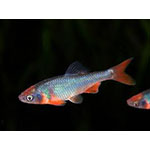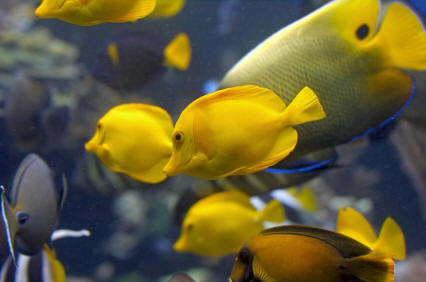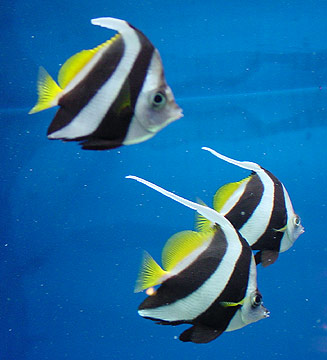Red Shinner

|
Scientific Name: Cyprinella lutrensis Price: Upon Request Origin: North America Family: Cyprinidae NOT AVAILABLE NOW |
|
Other Names: Rainbow Dace, Red-horse Minnow, Leuciscus lutrensis, Notropis lutrensis, Cyprinella beckwithi |
|
Technical Info
Temperature: 18 - 23 ℃
pH: 7.3 - 7.7
GH: 10 - 15
Max size: 8 cm
Min Tank size: 100 Ltr
Position in Aqua: Middle swimmer
Description
A rather slab-sided minnow. Yellowish-olive back with dark edgings on scales. Sides are silvery with blue reflections. Large young and adults have all membranes of the dorsal fin more or less uniformly dusted with fine, dark specks. Breeding males are a beautiful metallic blue with top of head and all fins (exept dorsal) bright red and have a pink vertical bar on body behind the pectoral fin.
Food
It will accept a wide range of foods, from a staple flake food to live and frozen bloodworm, mosquito larvae, brineshrimp and Daphnia.
Breeding
The spawning season for red shiners is generally from mid-April through September. In addition to spawning in crevices like other members of the genus Cyprinella, red shiners also broadcast their eggs and attach them to rocks and vegetation. Females can release up to 16 batches per day with up to 71 eggs per batch. The average clutch size, however, is 585 eggs and they may have five to 19 clutches in one reproductive season. Red shiners are capable of generating viable hybrid offspring with closely related species, such as the blue shiner and the blacktail shiner.
Compatible with
An active temperate fish that is quite colourful in the right housing. Can be housed with other cool-water fast-swimming fish such as White Cloud Mountain Minnows or Zebra Danios. Should not be housed with Goldfish as the Red Shiner can be a fin-nipping risk. They should be kept in groups of at least 4-5 of their own kind.
Note
Mature males will be far more colourful and have breeding tubercles similar to Goldfish when sexually mature.

